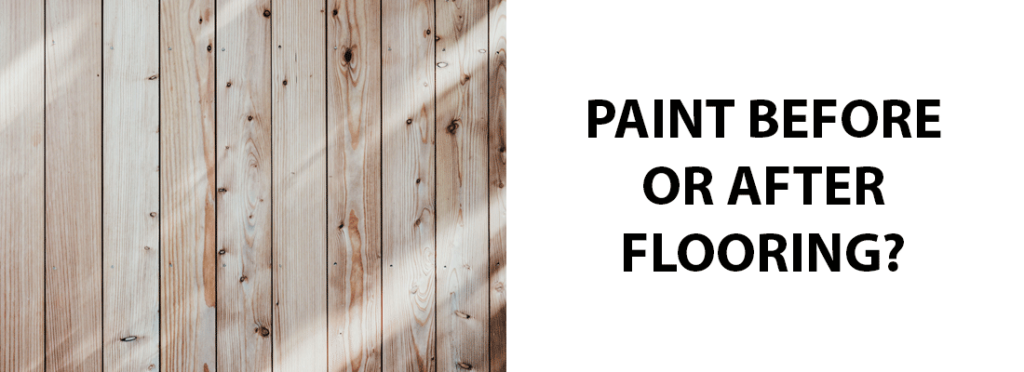Do you paint before or after flooring? It’s a pretty common question, and most people assume painting should come first. After all, who wants to risk spilling paint on brand-new floors? But in reality, new flooring should always be installed before tackling any interior painting. If you’re in the Sacramento area and you need a painter, we can help. We’re in Sacramento and serve the entire area including Roseville and El Dorado Hills.
Why Install Flooring Before Painting?
Installing flooring first simplifies the renovation process and prevents unnecessary damage to freshly painted walls. Flooring installation generally involves heavy tools, adhesives, and materials that can easily scuff, chip, or dent walls. By tackling the flooring first, you avoid the frustration of having to repair or repaint walls that could be accidentally damaged during the process.
Flooring projects also create dust, debris, and strong odors from adhesives or stains. Sanding hardwood or cutting tiles can send particles into the air, which can settle on wet paint or primers, ruining your finish. Completing the flooring first ensures the space is clean and ready for painting, giving you a smoother result.
Additionally, installing flooring first allows you to make precise adjustments to baseboards and trim, making certain they fit seamlessly with the new floor. It also helps you finalize wall colors that complement the flooring’s tone and texture, ensuring a cohesive and polished design. Starting with the flooring creates the perfect foundation for a beautifully finished space.
The Process
Before installing new flooring, there are several important steps to follow if you want the best results. Rushing this process can lead to damage or an uneven finish, so here’s a detailed guide to what you should do beforehand:
1. Remove the Old Flooring
The first step is to take out the existing flooring, whether it’s carpet, tile, hardwood, or laminate. This involves more than just pulling it up. You’ll also need to remove any leftover adhesive, nails, or staples. For tile floors, chipping away old grout and ensuring the subfloor is smooth is very important. A clean, level surface is a must for new flooring to lay evenly and adhere properly.
2. Replace or Repaint Trim
Once the old flooring is removed, assess the condition of the baseboards and trim. Damaged or outdated trim should be replaced at this stage. If the trim is still in good shape, now is the time to repaint it. Doing this before laying new flooring is much easier because you won’t have to worry about protecting the fresh floors from paint drips or scuffs.
3. Prepare the Walls
Before the flooring goes in, take care of any wall repairs or updates. This includes patching holes, sanding rough spots, and priming or painting areas that might need it. Preparing the walls now prevents dust, debris, or splatters from ruining your new flooring. If you plan to paint after the floors are installed, at least complete the wall prep work beforehand to minimize potential messes.
4. Mask and Protect
With the walls and trim prepped, the final step before flooring installation is masking. Use painter’s tape and plastic sheeting to protect the baseboards, lower parts of the walls, and any nearby furniture. Proper masking ensures tools, adhesives, and debris don’t damage other parts of the room. It’s a simple step that makes a big difference in keeping the space clean and tidy during installation.
Does the Type of Flooring Matter?
Different flooring types require specific precautions, but no matter what material you choose, flooring should always come before painting. Finished hardwood is a straightforward option—it’s installed as is, without much risk to the walls. However, unfinished hardwood needs extra steps, including staining and sanding. During these processes, stain can easily splatter onto freshly painted walls, leaving you with frustrating touch-ups or even a full repaint.
Sanding unfinished hardwood creates dust and wood shavings, which can also cause problems. If the proper drying time isn’t allowed, this debris can settle onto wet paint, ruining the smooth, clean finish you worked hard to achieve. These mishaps are easily avoided if you tackle the flooring first and save the painting for last.
What If You’re Installing Epoxy Flooring?
Epoxy flooring should always come before painting the walls, and for good reason. Installing epoxy involves multiple steps, including layering the epoxy itself and applying a final sealant. Each layer requires very precise application and specific curing times, making it a time-intensive process. The final sealant is particularly important because any dust, dirt, or debris that lands on it will be permanently trapped in the floor. This makes wall prep a major priority before starting the flooring process. Tasks like sanding, priming, or patching should be completed ahead of time to prevent messes that could ruin the floor’s finish. Once the epoxy is fully cured and sealed, you can safely move on to painting the walls without worry.
Do You Paint Before or After Flooring Conclusion
When it comes to renovations, starting with the flooring before painting is the smartest way to achieve a smooth and professional finish. Taking the right steps in the right order saves time, prevents damage, and guarantees your space looks its best.
If you’re planning an upgrade or renovation and need a trusted team to handle your painting projects, look no further than DL Painting. Based in the Sacramento area, we’re known for our exceptional craftsmanship, attention to detail, and commitment to customer satisfaction. Whether it’s a single room or a whole-home update, we’re here to bring your vision to life. Reach out to DL Painting today and let us help you make your space amazing!

